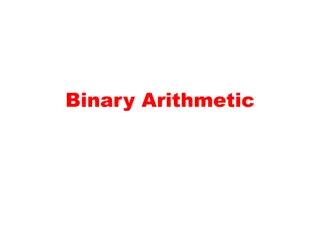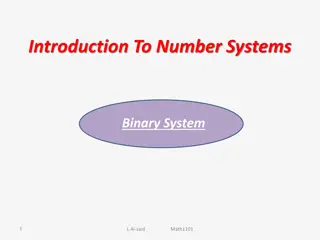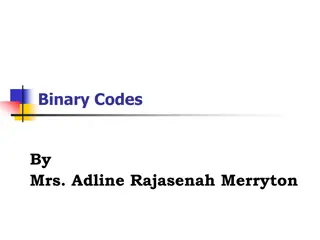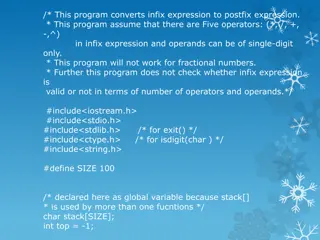Binary Tree Application: Expression Tree Implementation
Concept of expression trees in data structures and algorithms. Learn how expression trees are used to evaluate expressions and convert infix expressions to prefix or postfix notation. Discover the structure of expression trees and their application in representing arithmetic expressions. Dive into the implementation of expression trees in Python, including building the tree, evaluating expressions, and storing tree nodes. See an example of using the Expression Tree Abstract Data Type (ADT) to evaluate arithmetic expressions dynamically with variable values.
Download Presentation

Please find below an Image/Link to download the presentation.
The content on the website is provided AS IS for your information and personal use only. It may not be sold, licensed, or shared on other websites without obtaining consent from the author.If you encounter any issues during the download, it is possible that the publisher has removed the file from their server.
You are allowed to download the files provided on this website for personal or commercial use, subject to the condition that they are used lawfully. All files are the property of their respective owners.
The content on the website is provided AS IS for your information and personal use only. It may not be sold, licensed, or shared on other websites without obtaining consent from the author.
E N D
Presentation Transcript
CSCI 204: Data Structures & Algorithms Revised by Xiannong Meng based on textbook author s notes 1
Binary Tree Application Expression Tree Revised based on textbook author s notes.
Expression Trees A binary tree in which the operators are stored in the interior nodes and the operands are sored in the leaves. Used to evaluate an expression. Used to convert an infix expression to either prefix or postfix notation. We ve learned to evaluate expressions using stacks. The tree implementation will be a good contrast to that of a stack. 3
Expression Trees The tree structure is based on the order in which the operators are evaluated. Operators in lower-level nodes are evaluated first. The last operator evaluated is in the root node. 4
Expression Tree ADT An expression tree is a binary tree representation of an arithmetic expression. Contains various operators (+, -, *, /, %) Contains operands comprised of single integer digits and single-letter variables. ExpressionTree( exp_str ) evaluate( var_dict ) __str__() 5
Expression Tree Example We can use the ADT to evaluate basic arithmetic expressions of any size. # Create a dictionary containing values for the variables. vars = { 'a' : 5, 'b' : 12 } # Build the tree for a sample expression and evaluate it. exp_tree = ExpressionTree( "(a/(b-3))" ) print( "The result = ", exp_tree.evaluate(vars) ) # We can change the value assigned to a variable # and reevaluate. vars['a'] = 22 print( "The result = ", exp_tree.evaluate(vars) ) Try ex1.py 6
Expression Tree Implementation exptree.py class ExpressionTree : def __init__( self, exp_str ): self._exp_tree = None self._build_tree( exp_str ) # recursion def evaluate( self, var_map ): return self._eval_tree( self._exp_tree, var_map ) # recursion def __str__( self ): return self._build_string( self._exp_tree ) # ... # Storage class for creating the tree nodes. class _ExpTreeNode : def __init__( self, data ): self.element = data self.left = None self.right = None 7
Expression Tree Evaluation We can develop an algorithm to evaluate the expression. Each subtree represents a valid subexpression. Lower-level subtrees have higher precedence. For each node, the two subtrees must be evaluated first. How does it work? 8
Expression Tree Implementation class ExpressionTree : # ... def _eval_tree( self, subtree, var_dict ): # See if the node is a leaf node if subtree.left is None and subtree.right is None : # Is the operand a literal digit? if subtree.element >= '0' and subtree.element <= '9' : return int(subtree.element) else : # Or is it a variable? assert subtree.element in var_dict, "Invalid variable." return var_dict[subtree.element] # Otherwise, it's an operator that needs to be computed. else : # post-order traversal! # Evaluate the expression in the subtrees. lvalue = _eval_tree( subtree.left, var_dict ) rvalue = _eval_tree( subtree.right, var_dict ) # Evaluate the operator using a helper method. return compute_op( lvalue, subtree.element, rvalue ) exptree.py 10
String Representation To convert an expression tree to a string, we must perform an infix traversal. 8 * 5 + 9 / 7 - 4 11
String Representation The result was not correct because required parentheses were missing. Can easily create a fully parenthesized expression. ((8 * 5) + (9 / (7 - 4))) 12
Expression Tree Implementation exptree.py class ExpressionTree : # ... def _build_string( self, tree_node ): # If the node is a leaf, it's an operand. if tree_node.left is None and tree_node.right is None : return str( tree_node.element ) # Otherwise, it's an operator. else : # in-order traversal! exp_str = '(' exp_str += self._build_string( tree_node.left ) exp_str += str( tree_node.element ) exp_str += self._build_string( tree_node.right ) exp_str += ')' return exp_str 13
Expression Tree Construction An expression tree is constructed by parsing the fully-parenthesized expression and examining the tokens. New nodes are inserted as the tokens are examined. Each set of parentheses will consist of: an interior node for the operator two children either single valued or a subexperssion. 14
Expression Tree Construction For simplicity, we assume: the expression is stored in a string with no white space. the expression is valid and fully parenthesized. each operand will be a single-digit or single- letter variable. the operators will consist of +, -, *, /, % 15
Expression Tree Construction Consider the expression (8*5) The process starts with an empty root node set as the current node: The action at each step depends on the current token. 16
Expression Tree Construction When a left parenthesis is encountered: (8*5) a new node is created and linked as the left child of the current node. descend down to the new node. 17
Expression Tree Construction When an operand is encountered: (8*5) the data field of the current node is set to contain the operand. move up to the parent of current node. 18
Expression Tree Construction When an operator is encountered: (8*5) the data field of the current node is set to the operator. a new node is created and linked as the right child of the current node. descend down to the new node. 19
Expression Tree Construction Another operand is encountered: (8*5) 20
Expression Tree Construction When a right parenthesis: (8*5) move up to the parent of the current node. 21
Expression Example #2 Consider another expression: ((2*7)+8) 22
Expression Tree Implementation exptree.py class ExpressionTree : # ... def _build_tree( self, exp_str ): # Build a queue containing the tokens from the expression. expQ = Queue() for token in exp_str : expQ.enqueue( token ) # Create an empty root node. self._exp_tree = _ExpTreeNode( None ) # Call the recursive function to build the tree. self._rec_build_tree( self._exp_tree, expQ ) 23
Expression Tree Implementation exptree.py class ExpressionTree : # ... def _rec_build_tree( self, cur_node, expQ ): # Extract the next token from the queue. token = expQ.dequeue() # See if the token is a left paren: '(' if token == '(' : cur_node.left = _ExpTreeNode( None ) build_treeRec( cur_node.left, expQ ) # The next token will be an operator: + - / * % cur_node.data = expQ.dequeue() cur_node.right = _ExpTreeNode( None ) self._build_tree_rec( cur_node.right, expQ ) # The next token will be a ), remove it. expQ.dequeue() # Otherwise, the token is a digit. else : cur_node.element = token 24























